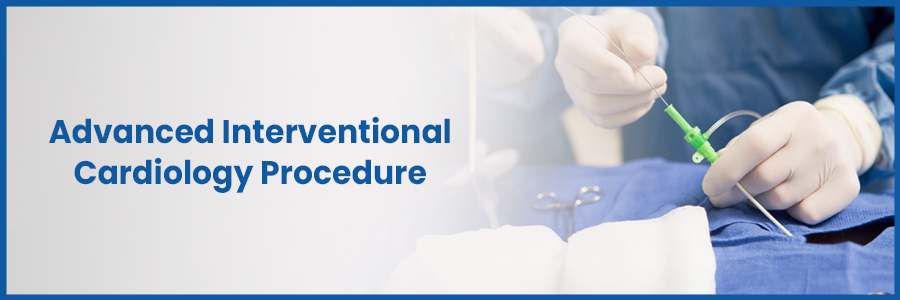
Advanced interventional cardiology procedures
Catheters are used in interventional cardiology to identify and treat heart problems. Healthcare professionals insert catheters, which are tiny tubes that resemble IVs, through your blood vessels. This is the reason why catheter-based surgery does not require an incision.
Cardiologists in this field treat patients with coronary (heart) and vascular (blood vessel) disorders. Individuals with structural heart problems can also benefit from them. These conditions include anomalies in the walls that divide your heart's chambers, known as septal defects, and heart valve defects.
Some interventional cardiologists work only with infants and young people who have congenital (born with) heart defects. Others concentrate on treating adult patients with congenital cardiac defects who require procedures.
What is the procedure for interventional cardiology?
As a subspecialty of cardiology, interventional cardiology uses tiny, flexible tubes called catheters to treat heart-related conditions that require interventional treatments.Your internist or cardiologist will recommend you to an interventional cardiologist, a specialist who carries out these treatments.
Interventional cardiology procedures list:- Angiograms and cardiac catheterization
- Carotid stenosis
- Interventional angioplasty and percutaneous coronary intervention (PCI)
- Septal ablation with alcohol
- closure of the atrial septal defect
- Aortic balloon valvuplasty
- Mitral balloon valvuplasty
- Closure of the left atrial appendage
- Foramen ovale patent closure
Live x-rays and, occasionally, ultrasonography are used to guide these operations. Although general anesthesia is not always necessary, most instances are completed via local anesthesia. Unless your specialist instructs you otherwise, you will return home the same day of your surgery. Your specialist will provide you with particular preparation instructions for each treatment. You will get discharge instructions from the hospital upon your release. These instructions are unique to each surgery.
Advanced Interventional Techniques
The categorization of Heart
This test assesses the strength of the heart muscle, the operation of the heart valves, and the quantity, location, and presence of plaque deposits in the arteries. A catheter is carefully guided toward the heart after being inserted into a blood vessel in the wrist or leg during a cardiac catheterization. In order to track the flow of blood through the heart's chambers and arteries, a cardiologist will inject contrast dye into the artery of the heart.
Coronary artery percutaneous intervention (PCI)
Restoring blood flow to a coronary artery is the aim of PCI, also referred to as angioplasty. PCI can be a planned procedure to treat chronically insufficient blood flow to the heart, or it can be an emergency treatment for a patient who has had a heart attack. A cardiologist will select the best instrument based on the individual anatomy of the patient to repair the heart vessels.
Angioplasty with balloons
The heart receives better blood flow after balloon angioplasty. The clogged artery is reached by inserting a catheter that has a balloon at the tip. The artery's walls are stretched open by inflating the balloon at the location of the blockage.
Atherectomy
During this procedure, hardened blockages in the coronary arteries are opened using a specialized pulverizing device. Often, atherectomy is carried out in conjunction with balloon angioplasty. The blockage is then frequently filled with a stent.
Implantation of Stents
A tiny metal coil or mesh tube known as a stent may be inserted into the artery following balloon angioplasty or atherectomy. The stent is attached to the end of a catheter, which is then guided up to the heart via a blood vessel in the wrist or leg. This prevents recently opened arteries from collapsing.
Interventional Cardiology: The Benefits of Penn Medicine
Working in one of the most cutting-edge programs, Penn interventional cardiologists have some of the most experience in the country. Individuals seeking our care gain from our:
- Innovative, research-driven care: Our team provides the entire spectrum of interventional cardiology procedures that are supported by evidence, including those that are currently undergoing clinical trials. Long before they were generally accessible, we provided cutting-edge medical procedures like Mitral Balloon Valvuloplasty, intravascular lithotripsy, transcatheter aortic valve replacement (TAVR), and MitraClipTM. You are selecting a team at Penn that has a track record of creating and swiftly implementing cutting-edge therapies.
- Patient-centered, subspecialized approach: Certain diagnoses, treatments, and procedures are areas of specialization for our interventional cardiologists. Because of our specialized knowledge, we can offer you cutting-edge treatments from highly qualified professionals. Additionally, we routinely have some of the highest patient satisfaction scores in the country. Get to know our treatment team for interventional cardiology.
- Outstanding results: Clinically proven interventional cardiology procedures, including those presently undergoing clinical trials, are all offered by our team. We offered state-of-the-art medical procedures such as transcatheter aortic valve replacement (TAVR), intravascular lithotripsy, mitral balloon valvuloplasty, and MitraClipTM long before they were widely available. You are choosing a Penn team that has a history of developing and quickly implementing innovative treatments.
- Treatment for complex cases: As a leading regional referral center, we handle the most severe and intricate cases of blood vessel and heart disease. Our interventional cardiologists provide cutting-edge treatments if you have been denied open-heart surgery or if the risks of surgery are too great for you.
- Cutting-edge technology: Our state-of-the-art catheterization (cath) lab is where we perform many cardiology procedures. Additionally, we have four hybrid operating rooms where we work with surgeons to perform cutting-edge procedures like nonsurgical valve replacements and hybrid revascularization.
Conclusion:
Over the past few decades, interventional cardiology has seen many changes that have significantly decreased the likelihood of unfavorable clinical outcomes for patients. After occlusion and acute vascular thrombosis, the next step in the long-term strategy to reduce complications from percutaneous coronary interventions was to suppress cell proliferation and NIH. After that, late and extremely late thrombosis gradually declined as implantable devices were developed.
